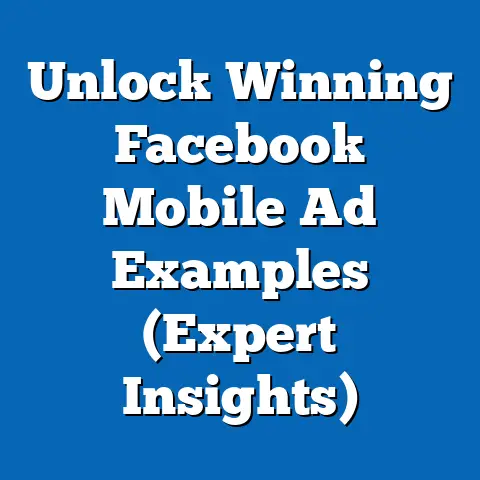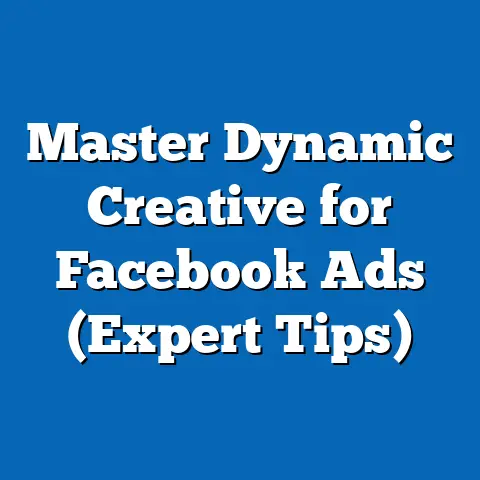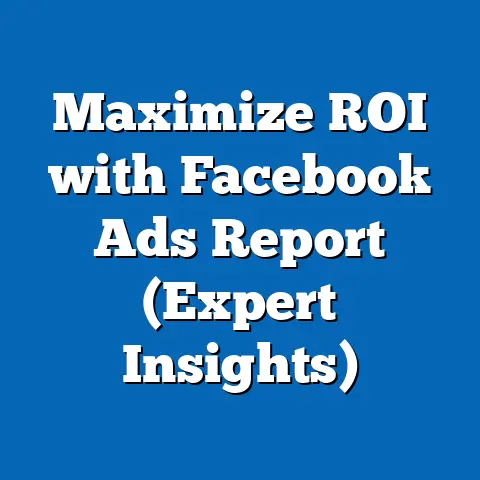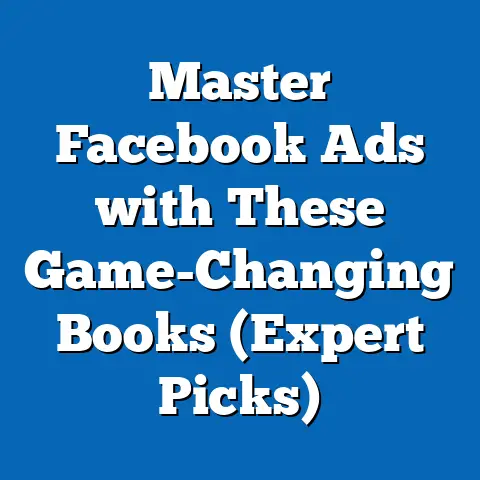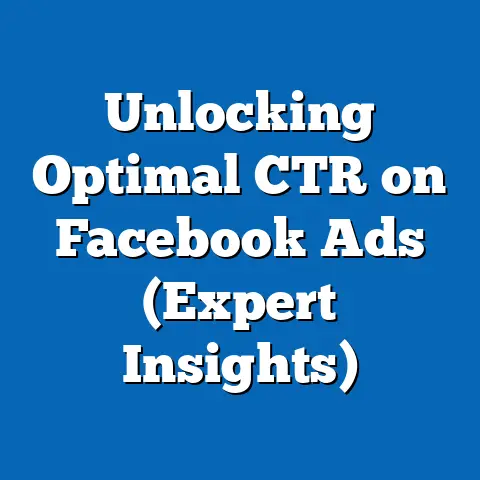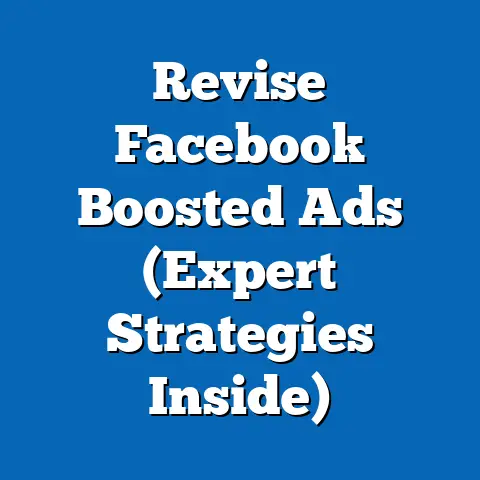Master Contact Facebook Ads Today (Essential Strategies)
Facebook Ads. The mere mention can send shivers down the spines of some marketers, while others see dollar signs dancing in their heads. I’ve been in both camps, trust me. Early on, I remember feeling overwhelmed, throwing money into the digital abyss and hoping something stuck. But over the years, I’ve learned that Facebook Ads, when approached strategically, can be an incredibly powerful tool for businesses of all sizes.
Whether you’re a solopreneur hustling from your kitchen table or a seasoned marketing pro managing a multi-million dollar budget, Facebook Ads offer a unique opportunity to connect with your ideal audience, build brand awareness, and drive real, measurable results. The key? Mastering the platform.
This isn’t just about clicking a few buttons and hoping for the best. It’s about understanding the intricate workings of Facebook’s algorithm, crafting compelling ad copy, targeting the right people, and continuously optimizing your campaigns for maximum impact.
Here’s what we’ll cover:
- Understanding Facebook Ads: What they are, why they’re important, and the different types available.
- Setting Up Your Facebook Ads Account: A step-by-step guide to creating and navigating your Business Manager and Ads Manager.
- Defining Your Objectives and Target Audience: How to set clear, measurable goals and identify your ideal customer.
- Crafting Compelling Ads: The key components of a successful ad, including visuals, copy, and call-to-action.
- Budgeting and Bidding Strategies: How to allocate your budget effectively and choose the right bidding strategy for your objectives.
- Analyzing and Optimizing Your Ads: How to track your performance, identify areas for improvement, and make data-driven decisions.
So, buckle up, grab a cup of coffee (or tea, if that’s your thing), and let’s dive into the world of Facebook Ads!
Section 1: Understanding Facebook Ads
Before we jump into the technical stuff, let’s lay a solid foundation by understanding what Facebook Ads are and why they’re such a big deal.
What Are Facebook Ads?
Simply put, Facebook Ads are paid advertisements that appear on Facebook, Instagram, and the Audience Network. These ads can take many forms, from simple image ads to engaging video ads and interactive experiences. The beauty of Facebook Ads lies in their ability to reach a highly targeted audience based on a wide range of criteria, including demographics, interests, behaviors, and more.
Think of it like this: imagine you’re hosting a party, and you want to invite only people who love to dance, enjoy Italian food, and live within a 10-mile radius. Facebook Ads allow you to do just that – invite the right people to your party (or in this case, your business).
Here’s a breakdown of some of the most common types of Facebook Ads:
- Image Ads: These are single-image ads that are simple, visually appealing, and effective for showcasing your product or service. I’ve found that high-quality images that tell a story tend to perform best.
- Video Ads: Video is king! Video ads are highly engaging and can be used to tell a more in-depth story, demonstrate your product, or share customer testimonials. I’ve seen video ads skyrocket engagement rates compared to image ads alone.
- Carousel Ads: Carousel ads allow you to showcase multiple images or videos in a single ad unit. This is great for highlighting different features of a product or telling a sequential story. I once used a carousel ad to showcase different outfits from a clothing boutique, and it drove significant traffic to their online store.
- Collection Ads: These ads are designed for e-commerce businesses and allow users to browse and purchase products directly from the ad. I’ve seen collection ads significantly increase conversion rates for online retailers.
- Lead Ads: Lead ads are designed to capture leads directly within Facebook. They allow users to submit their contact information without leaving the platform, making it easy for businesses to collect valuable leads. I’ve used lead ads for various clients, from real estate agents to insurance providers, and they’ve consistently generated high-quality leads.
- Instant Experience Ads (formerly Canvas Ads): These are full-screen, mobile-optimized ads that provide an immersive experience for users. They’re great for telling a brand story or showcasing a product in detail. I once created an Instant Experience ad for a travel agency, and it allowed users to virtually explore different destinations, which significantly increased engagement and bookings.
Why Use Facebook Ads?
With so many marketing channels available, why should you invest your time and money in Facebook Ads? Here’s why:
- Massive Reach: Facebook has billions of active users worldwide, making it one of the largest platforms for reaching your target audience. No matter who you’re trying to reach, chances are they’re on Facebook.
- Precise Targeting: As I mentioned earlier, Facebook’s targeting capabilities are incredibly powerful. You can target users based on demographics, interests, behaviors, location, and even their past interactions with your business. This allows you to ensure that your ads are seen by the people who are most likely to be interested in your product or service.
- Cost-Effectiveness: Compared to traditional advertising methods like TV or print, Facebook Ads can be incredibly cost-effective. You can set your own budget and control how much you spend, and you can track your results to see exactly how much you’re paying for each lead or conversion.
- Measurable Results: Facebook Ads Manager provides detailed analytics that allow you to track the performance of your campaigns. You can see how many people saw your ad, how many clicked on it, how many converted, and more. This data allows you to optimize your campaigns for maximum ROI.
- Brand Awareness: Even if you’re not trying to generate leads or sales, Facebook Ads can be a great way to increase brand awareness and reach a wider audience. By running targeted ads that showcase your brand’s message and values, you can build a strong brand presence on Facebook and Instagram.
- Retargeting: Facebook allows you to retarget users who have previously interacted with your business, such as visiting your website or engaging with your Facebook page. This is a highly effective way to re-engage potential customers and drive conversions. I’ve seen retargeting campaigns significantly increase conversion rates for many of my clients.
To illustrate the effectiveness of Facebook Ads, let’s look at a few real-world examples:
- Case Study 1: E-commerce Business A small online clothing boutique used Facebook Ads to target women aged 25-45 who were interested in fashion and online shopping. By running targeted image ads and carousel ads, they were able to increase their website traffic by 30% and their online sales by 20% in just one month.
- Case Study 2: Local Restaurant A local restaurant used Facebook Ads to target people who lived within a 5-mile radius and were interested in dining out. By running targeted ads that showcased their menu and special offers, they were able to increase their foot traffic by 15% and their overall revenue by 10% in just two weeks.
- Case Study 3: B2B Software Company A B2B software company used Facebook Ads to target professionals in specific industries who were interested in their software solution. By running targeted lead ads, they were able to generate high-quality leads at a fraction of the cost of traditional lead generation methods.
These are just a few examples of how Facebook Ads can be used to achieve different business goals. The key is to understand your target audience, create compelling ads, and continuously optimize your campaigns for maximum impact.
Key Takeaway: Facebook Ads are a powerful tool for businesses of all sizes. They offer massive reach, precise targeting, cost-effectiveness, and measurable results. By understanding the different types of ads and the benefits of using them, you can start to leverage Facebook Ads to achieve your business goals.
Next Step: Let’s move on to setting up your Facebook Ads account and navigating the Ads Manager.
Section 2: Setting Up Your Facebook Ads Account
Okay, now that we’ve established the “why,” let’s get into the “how.” Setting up your Facebook Ads account might seem daunting at first, but I promise it’s not as complicated as it looks. I’ll break it down into simple, step-by-step instructions.
Creating a Facebook Business Manager Account
The first step is to create a Facebook Business Manager account. This is where you’ll manage all of your Facebook pages, ad accounts, and other business assets. Think of it as your central hub for all things Facebook advertising.
Here’s how to set it up:
- Go to business.facebook.com: This will take you to the Facebook Business Manager website.
- Click “Create Account”: Follow the on-screen instructions to create your account. You’ll need to provide your business name, your name, and your business email address.
- Verify Your Email Address: Facebook will send you a verification email. Click the link in the email to verify your address.
- Add Your Facebook Page: Once your account is set up, you’ll need to add your Facebook page. If you don’t have a Facebook page yet, you’ll need to create one.
- Create an Ad Account: Next, you’ll need to create an ad account. This is where you’ll manage your Facebook Ads campaigns. You’ll need to provide your business name, your country, and your currency.
Why is a Business Manager account so important?
- Separation of Personal and Business: It keeps your personal Facebook profile separate from your business activities. This is crucial for maintaining privacy and professionalism. I learned this the hard way when I accidentally posted a personal update on a client’s Facebook page. Ouch!
- Team Management: It allows you to grant access to your Facebook page and ad account to other members of your team without giving them your personal login information. This is essential for collaboration and delegation.
- Centralized Management: It provides a central location for managing all of your Facebook business assets, including your Facebook page, ad account, Instagram account, and more. This makes it easier to stay organized and manage your online presence.
- Enhanced Security: It offers enhanced security features that protect your business assets from unauthorized access.
Navigating Ads Manager
Once you have your Business Manager account set up, you’ll need to navigate the Ads Manager. This is where you’ll create, manage, and analyze your Facebook Ads campaigns.
Here’s a quick overview of the key sections of Ads Manager:
- Campaigns: This is where you’ll create and manage your Facebook Ads campaigns. A campaign is a high-level organizational structure that contains one or more ad sets and ads.
- Ad Sets: An ad set is a group of ads that share the same targeting, budget, and schedule. This is where you’ll define your target audience, set your budget, and choose your ad placements.
- Ads: This is where you’ll create your individual Facebook Ads. You’ll choose your ad format, write your ad copy, and upload your images or videos.
- Reporting: This is where you’ll track the performance of your Facebook Ads campaigns. You can see how many people saw your ad, how many clicked on it, how many converted, and more.
- Audiences: This is where you can create and manage your target audiences. You can create custom audiences based on your website traffic, email list, or other data sources.
- Business Settings: This is where you can manage your Business Manager account settings, including adding team members, connecting your Facebook page, and managing your payment information.
Tips for navigating Ads Manager:
- Familiarize yourself with the interface: Take some time to explore the different sections of Ads Manager and get comfortable with the layout.
- Use the search bar: The search bar is your friend! Use it to quickly find specific campaigns, ad sets, or ads.
- Customize your columns: Customize the columns in your reporting dashboard to show the metrics that are most important to you.
- Use filters: Use filters to quickly find specific campaigns, ad sets, or ads based on their status, budget, or other criteria.
- Take advantage of Facebook’s resources: Facebook offers a wealth of resources to help you learn how to use Ads Manager, including tutorials, guides, and webinars.
Key Takeaway: Setting up your Facebook Ads account and navigating Ads Manager is the first step to mastering Facebook advertising. By creating a Business Manager account and familiarizing yourself with the Ads Manager interface, you’ll be well on your way to creating and managing successful Facebook Ads campaigns.
Next Step: Let’s move on to defining your objectives and target audience.
Section 3: Defining Your Objectives and Target Audience
Now that you have your Facebook Ads account set up, it’s time to start thinking about your goals and who you want to reach. This is a crucial step in the process, as it will inform your entire Facebook Ads strategy.
Setting Clear Objectives
Before you start creating ads, it’s important to define your objectives. What do you want to achieve with your Facebook Ads campaigns? Are you trying to increase brand awareness, generate leads, drive website traffic, or boost sales?
Here are some common objectives for Facebook Ads campaigns:
- Brand Awareness: Increase awareness of your brand and reach a wider audience.
- Reach: Show your ad to as many people as possible within your target audience.
- Traffic: Drive traffic to your website or landing page.
- Engagement: Increase engagement with your Facebook page, such as likes, comments, and shares.
- App Installs: Drive installs of your mobile app.
- Video Views: Increase views of your video content.
- Lead Generation: Collect leads from potential customers.
- Conversions: Drive sales or other conversions on your website.
- Catalog Sales: Promote products from your e-commerce catalog.
- Store Traffic: Drive traffic to your physical store location.
Why are clear objectives so important?
- Focus: They help you focus your efforts and ensure that your Facebook Ads campaigns are aligned with your overall business goals.
- Measurement: They allow you to measure the success of your campaigns and track your progress towards your goals.
- Optimization: They provide a framework for optimizing your campaigns and making data-driven decisions.
Tips for setting clear objectives:
- Be Specific: Don’t just say you want to “increase sales.” Instead, set a specific goal, such as “increase online sales by 20% in the next quarter.”
- Be Measurable: Make sure your objectives are measurable so you can track your progress and determine whether you’re achieving your goals.
- Be Achievable: Set realistic goals that are challenging but attainable.
- Be Relevant: Make sure your objectives are relevant to your overall business goals.
- Be Time-Bound: Set a timeframe for achieving your objectives.
Targeting Your Audience
Once you have your objectives defined, it’s time to start thinking about your target audience. Who are you trying to reach with your Facebook Ads campaigns?
Facebook offers a wide range of targeting options, allowing you to reach a highly specific audience based on demographics, interests, behaviors, and more.
Here are some of the most common targeting options:
- Location: Target users based on their location, such as country, state, city, or zip code.
- Age: Target users based on their age range.
- Gender: Target users based on their gender.
- Language: Target users based on their language.
- Demographics: Target users based on their education, relationship status, job title, and other demographic information.
- Interests: Target users based on their interests, such as hobbies, activities, and favorite brands.
- Behaviors: Target users based on their online behaviors, such as their purchase history, website visits, and Facebook activity.
- Connections: Target users who are connected to your Facebook page or have interacted with your business in the past.
- Custom Audiences: Create custom audiences based on your website traffic, email list, or other data sources.
- Lookalike Audiences: Create lookalike audiences based on your existing customers or website visitors. This is a powerful way to reach new potential customers who are similar to your best customers.
Tips for targeting your audience:
- Research Your Audience: Before you start creating ads, take some time to research your target audience. What are their interests, behaviors, and pain points?
- Use Multiple Targeting Options: Don’t rely on just one targeting option. Combine multiple targeting options to reach a more specific audience.
- Test Different Audiences: Test different audiences to see which ones perform best. You can create multiple ad sets with different targeting options and compare their results.
- Use Custom Audiences: Custom audiences are a powerful way to retarget users who have previously interacted with your business.
- Use Lookalike Audiences: Lookalike audiences are a great way to reach new potential customers who are similar to your best customers.
Example:
Let’s say you’re selling organic dog food. Here’s how you might define your target audience:
- Location: United States
- Age: 25-55
- Gender: Male and Female
- Interests: Dogs, Dog Food, Organic Food, Pet Supplies
- Behaviors: Pet Owners, Online Shoppers
You could also create a custom audience of people who have visited your website in the past or who are on your email list. And you could create a lookalike audience based on your existing customers.
Key Takeaway: Defining your objectives and target audience is a crucial step in the Facebook Ads process. By setting clear, measurable goals and identifying your ideal customer, you can create more effective Facebook Ads campaigns that drive real results.
Next Step: Let’s move on to crafting compelling ads that capture your audience’s attention and drive them to take action.
Now comes the fun part: creating the ads themselves! This is where your creativity comes into play. A compelling ad is the key to capturing your audience’s attention and driving them to take action.Key Components of an Effective Ad
A successful Facebook ad is more than just a pretty picture. It’s a carefully crafted combination of visuals, copy, and call-to-action (CTA) that resonates with your target audience and prompts them to take the desired action.
Let’s break down each of these components:
- Visuals: Your ad’s visuals are the first thing people will see, so it’s important to make them eye-catching and relevant. Use high-quality images or videos that tell a story and capture your audience’s attention.
- Images: Choose images that are visually appealing and relevant to your product or service. Use images that showcase your product in action or that evoke a particular emotion. I’ve found that images with people in them tend to perform better than images without people.
- Videos: Video is a powerful medium for telling stories and engaging your audience. Use videos to demonstrate your product, share customer testimonials, or provide valuable information. Keep your videos short and sweet, as people have short attention spans on social media.
- Copy: Your ad copy is what will convince people to take action. Use clear, concise language that highlights the benefits of your product or service. Focus on the pain points of your target audience and how your product or service can solve them.
- Headline: Your headline is the first thing people will read, so it’s important to make it attention-grabbing and relevant. Use a headline that highlights the main benefit of your product or service.
- Description: Your description provides more detail about your product or service. Use this space to highlight the key features and benefits.
- Call-to-Action (CTA): Your CTA tells people what you want them to do. Use a clear, concise CTA that prompts people to take action, such as “Learn More,” “Shop Now,” or “Sign Up.”
- Placement: Make sure your CTA is prominently displayed in your ad.
- Relevance: Choose a CTA that is relevant to your objective. For example, if you’re trying to drive traffic to your website, use a CTA like “Learn More.” If you’re trying to generate leads, use a CTA like “Sign Up.”
- Images: Choose images that are visually appealing and relevant to your product or service. Use images that showcase your product in action or that evoke a particular emotion. I’ve found that images with people in them tend to perform better than images without people.
- Videos: Video is a powerful medium for telling stories and engaging your audience. Use videos to demonstrate your product, share customer testimonials, or provide valuable information. Keep your videos short and sweet, as people have short attention spans on social media.
- Headline: Your headline is the first thing people will read, so it’s important to make it attention-grabbing and relevant. Use a headline that highlights the main benefit of your product or service.
- Description: Your description provides more detail about your product or service. Use this space to highlight the key features and benefits.
- Placement: Make sure your CTA is prominently displayed in your ad.
- Relevance: Choose a CTA that is relevant to your objective. For example, if you’re trying to drive traffic to your website, use a CTA like “Learn More.” If you’re trying to generate leads, use a CTA like “Sign Up.”
Tips for creating eye-catching visuals:
- Use high-quality images and videos: Low-quality visuals will turn people off.
- Use bright, vibrant colors: Bright colors will help your ad stand out in the newsfeed.
- Use images with people in them: As I mentioned earlier, images with people in them tend to perform better than images without people.
- Use images that tell a story: Images that tell a story will capture your audience’s attention and make them more likely to engage with your ad.
- Use videos to demonstrate your product: Videos are a great way to showcase the features and benefits of your product.
Copywriting Tips
Writing engaging ad copy is an art form. It’s about capturing your audience’s attention, highlighting the benefits of your product or service, and prompting them to take action – all in a few short sentences.
Here are some practical copywriting tips for writing effective Facebook Ads copy:
- Know Your Audience: Before you start writing, make sure you understand your target audience. What are their pain points, desires, and motivations?
- Focus on Benefits, Not Features: Instead of focusing on the features of your product or service, focus on the benefits. How will your product or service improve their lives?
- Use Strong Verbs: Use strong verbs to make your copy more engaging and action-oriented. Examples: “Discover,” “Transform,” “Unleash.”
- Create a Sense of Urgency: Create a sense of urgency to encourage people to take action now. Examples: “Limited Time Offer,” “Sale Ends Soon,” “Don’t Miss Out.”
- Use Social Proof: Use social proof to build trust and credibility. Examples: “Join Thousands of Satisfied Customers,” “Rated 5 Stars,” “As Seen On.”
- Ask Questions: Asking questions can be a great way to engage your audience and make them think about their needs and desires.
- Keep It Short and Sweet: People have short attention spans on social media, so keep your copy short and sweet. Get to the point quickly and highlight the most important information.
- Use Emojis: Emojis can be a great way to add personality and emotion to your ad copy. However, use them sparingly and make sure they’re relevant to your message.
- Test Different Versions: Test different versions of your ad copy to see which one performs best. You can use A/B testing to compare different headlines, descriptions, and CTAs.
Examples of effective messaging:
- Bad: “Our product is a high-quality widget with lots of features.”
- Good: “Solve your biggest problem with our easy-to-use widget that saves you time and money.”
- Bad: “We’re having a sale on all of our products.”
- Good: “Limited Time Offer: Get 20% off all products this week only! Don’t miss out!”
Key Takeaway: Crafting compelling ads is essential for the success of your Facebook Ads campaigns. By using high-quality visuals, writing engaging ad copy, and using clear CTAs, you can capture your audience’s attention and drive them to take action.
Next Step: Let’s move on to budgeting and bidding strategies.
Section 5: Budgeting and Bidding Strategies
You’ve got your ads created, now it’s time to talk money! Understanding how to set your budget and choose the right bidding strategy is crucial for maximizing your ROI on Facebook Ads.
Setting Your Budget
Facebook offers several budgeting options, allowing you to control how much you spend on your ads.
Here are the main budgeting options:
- Daily Budget: This is the average amount you’re willing to spend on your ads each day. Facebook will try to spend this amount each day, but it may spend slightly more or less depending on the performance of your ads.
- Lifetime Budget: This is the total amount you’re willing to spend on your ads over the entire duration of the campaign. Facebook will try to spread your budget evenly over the campaign duration.
- Ad Spend Limits: You can set ad spend limits at the campaign level, ad set level, or ad level. This allows you to control how much you spend on specific ads or ad sets.
How to determine an appropriate budget:
- Start Small: If you’re new to Facebook Ads, it’s best to start with a small budget and gradually increase it as you see results. I recommend starting with a daily budget of $5-$10 per ad set.
- Consider Your Goals: Your budget should be aligned with your goals. If you’re trying to increase brand awareness, you’ll need a larger budget than if you’re trying to generate leads.
- Think About Your Target Audience: The size of your target audience will also affect your budget. If you’re targeting a small, niche audience, you may be able to get away with a smaller budget. If you’re targeting a large, broad audience, you’ll need a larger budget.
- Calculate Your ROI: Before you start running ads, calculate your potential return on investment (ROI). How much revenue will you generate from each lead or conversion? This will help you determine how much you’re willing to spend on your ads.
- Monitor Your Results: Continuously monitor your results and adjust your budget as needed. If you’re seeing good results, you can increase your budget. If you’re not seeing good results, you can decrease your budget or try a different targeting strategy.
Bidding Strategies
Facebook offers several bidding strategies, allowing you to control how much you pay for each ad impression or click.
Here are the main bidding strategies:
- Cost Per Click (CPC): You pay each time someone clicks on your ad. This is a good option if you’re trying to drive traffic to your website.
- Cost Per Impression (CPM): You pay each time your ad is shown to someone. This is a good option if you’re trying to increase brand awareness.
- Cost Per Action (CPA): You pay each time someone takes a specific action, such as making a purchase or filling out a lead form. This is a good option if you’re trying to generate leads or drive sales.
- Automatic Bidding: Facebook automatically sets your bids for you based on your budget and goals. This is a good option if you’re new to Facebook Ads or if you don’t want to spend time manually setting your bids.
- Manual Bidding: You manually set your bids for each ad. This gives you more control over your spending, but it also requires more time and effort.
How to choose the right bidding strategy:
- Consider Your Goals: Your bidding strategy should be aligned with your goals. If you’re trying to drive traffic to your website, CPC bidding is a good option. If you’re trying to increase brand awareness, CPM bidding is a good option. If you’re trying to generate leads or drive sales, CPA bidding is a good option.
- Test Different Strategies: Test different bidding strategies to see which one performs best. You can create multiple ad sets with different bidding strategies and compare their results.
- Start with Automatic Bidding: If you’re new to Facebook Ads, it’s best to start with automatic bidding and gradually switch to manual bidding as you become more experienced.
- Monitor Your Results: Continuously monitor your results and adjust your bidding strategy as needed. If you’re not seeing good results, you can try a different bidding strategy or adjust your bids.
Key Takeaway: Setting your budget and choosing the right bidding strategy are crucial for maximizing your ROI on Facebook Ads. By understanding the different budgeting options and bidding strategies, you can control how much you spend on your ads and ensure that you’re getting the best possible results.
Next Step: Let’s move on to analyzing and optimizing your ads.
Section 6: Analyzing and Optimizing Your Ads
You’ve launched your Facebook Ads campaigns, but the work doesn’t stop there! Analyzing your results and optimizing your ads is essential for maximizing your ROI and achieving your goals. This is where the magic truly happens.
Key Performance Indicators (KPIs)
To effectively analyze your Facebook Ads performance, you need to track the right Key Performance Indicators (KPIs). These are the metrics that will tell you whether your campaigns are on track and whether you’re achieving your goals.
Here are some essential KPIs for measuring the success of Facebook Ads:
- Impressions: The number of times your ad was shown to someone. This is a good indicator of your reach.
- Reach: The number of unique people who saw your ad. This is a good indicator of your brand awareness.
- Click-Through Rate (CTR): The percentage of people who saw your ad and clicked on it. This is a good indicator of your ad’s relevance and effectiveness.
- Cost Per Click (CPC): The average cost you paid for each click on your ad. This is a good indicator of your ad’s efficiency.
- Conversion Rate: The percentage of people who clicked on your ad and completed a desired action, such as making a purchase or filling out a lead form. This is a good indicator of your ad’s effectiveness in driving conversions.
- Cost Per Conversion (CPA): The average cost you paid for each conversion. This is a good indicator of your ad’s efficiency in driving conversions.
- Return on Ad Spend (ROAS): The amount of revenue you generated for every dollar you spent on ads. This is the ultimate measure of your ad’s effectiveness.
Tips for tracking your KPIs:
- Use Facebook Ads Manager: Facebook Ads Manager provides detailed analytics that allow you to track the performance of your campaigns.
- Customize Your Columns: Customize the columns in your reporting dashboard to show the metrics that are most important to you.
- Use Filters: Use filters to quickly find specific campaigns, ad sets, or ads based on their status, budget, or other criteria.
- Track Your Results Over Time: Track your results over time to see how your campaigns are performing and identify any trends.
- Compare Your Results to Industry Benchmarks: Compare your results to industry benchmarks to see how you’re performing relative to your competitors.
A/B Testing
A/B testing is a powerful technique for optimizing your ads and improving your results. It involves testing two different versions of an ad against each other to see which one performs better.
Here’s how to conduct A/B tests:
- Choose an Element to Test: Choose an element of your ad that you want to test, such as the headline, description, image, or CTA.
- Create Two Versions of the Ad: Create two versions of the ad with different variations of the element you’re testing. For example, you could test two different headlines or two different images.
- Run the Ads Simultaneously: Run the two versions of the ad simultaneously to the same target audience.
- Track Your Results: Track your results and compare the performance of the two versions of the ad.
- Implement the Winning Version: Implement the winning version of the ad and continue to test other elements to further optimize your results.
What elements should you test?
Let’s say you want to test two different headlines for your ad:
- Version A: “Get 20% Off All Products This Week Only!”
- Version B: “Limited Time Offer: Save 20% on All Products!”
You would run these two ads simultaneously to the same target audience and track their results. After a week, you would analyze the results and see which headline performed better. If Version A generated more clicks and conversions, you would implement that headline and continue to test other elements of your ad.
Making Data-Driven Decisions
The key to optimizing your Facebook Ads campaigns is to make data-driven decisions. This means using the data you collect from Facebook Ads Manager to inform your decisions about how to improve your campaigns.
Here are some tips for making data-driven decisions:
- Analyze Your KPIs: Analyze your KPIs to identify areas where your campaigns are performing well and areas where they need improvement.
- Identify Trends: Look for trends in your data to see how your campaigns are performing over time.
- Experiment: Don’t be afraid to experiment with different targeting options, ad creatives, and bidding strategies.
- Be Patient: Optimization takes time. Don’t expect to see results overnight.
- Continuously Monitor and Adjust: Continuously monitor your results and adjust your campaigns as needed.
Key Takeaway: Analyzing and optimizing your ads is essential for maximizing your ROI on Facebook Ads. By tracking your KPIs, conducting A/B tests, and making data-driven decisions, you can continuously improve your campaigns and achieve your goals.
Remember, mastering Facebook Ads is an ongoing process. It requires continuous learning, experimentation, and adaptation. The platform is constantly evolving, so it’s important to stay up-to-date on the latest features and best practices.
Don’t be afraid to experiment with different targeting options, ad creatives, and bidding strategies. The key is to find what works best for your business and your target audience.
Take the first steps toward implementing the strategies you’ve learned in this guide. Set up your Facebook Ads account, define your objectives, target your audience, craft compelling ads, set your budget, and analyze your results.
And don’t get discouraged if you don’t see results immediately. It takes time to optimize your campaigns and find the right formula for success. But with persistence and dedication, you can achieve your advertising goals and drive real results for your business.
I’ve seen firsthand how Facebook Ads can transform businesses of all sizes. From small startups to large corporations, Facebook Ads can be a powerful tool for reaching your target audience, building brand awareness, and driving sales.
So, go out there and conquer the Facebook Ads world! I believe in you. You have the knowledge, the tools, and the strategies to succeed.
Now, go make some magic happen!

